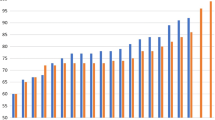Abstract
Introduction
Locking plate is considered biomechanically advantageous for porotic bone, compared with conventional plate. However, clinical evaluations of locking and conventional plates for periprosthetic femoral fracture are still controversial. Thus, we investigated the usefulness of a locking plate compared with the conventional plate for treatment for this fracture.
Materials and methods
We reviewed 40 patients (40 fractures) who had undergone internal fixation for Vancouver type B1 or C periprosthetic fracture. Locking and conventional plates were applied for 21 and 19 patients, respectively.
Results
No significant difference was found between locking and conventional plate groups in Merle d’ Aubigné hip score, walking ability, operation time, and blood loss. Regarding postoperative complications, delayed union was noted in one patient in the locking plate group and subsidence of the stem in one in the conventional plate group. On the final follow-up, bone union was achieved in all patients.
Conclusion
We cannot suggest the usefulness of locking plate for periprosthetic femoral fracture. However, functional training was performed in the same rehabilitation schedule in our comparative study. Considering the angle stability of the locking plate, weight may be loaded on the locking plate, earlier than that on the conventional plate, which may be an advantage of the locking plate.



Similar content being viewed by others
References
Learmonth ID (2004) Aspects of current management. The management of periprosthetic fractures around the femoral stem. J Bone Joint Surg Br 86:13–19
Masri BA, Meek D, Duncan CP (2004) Periprosthetic fractures evaluation and treatment. Clin Orthop 420:80–95
Kavanagh BF (1992) Femoral fracture associated with total hip arthroplasty. Orthop Clin North Am 23:249–257
Greidanus NV, Mitchell PA, Masri BA et al (2003) Principle of management and results of treating the fractured femur during and after total hip arthroplasty. AAOS instructional course lecture 52:309–322
Holley K, Zelken J, Padgett D et al (2007) Periprosthetic fractures of the femur after hip arthroplasty: an analysis of 99 patients. HSS J 3:190–197
Gautier E, Sommer C (2003) Guidelines for the clinical application of the LCP. Injury 34:63–76
Wood GC, Naudie DR, Mcauley J, McCalden RW (2011) Locking compression plates for the treatment of periprosthetic femoral fractures around well-fixed total hip and knee implants. J Arthroplasty 26:886–892
Ginger KB, Saam M, Julie AM et al (2009) Isolated locked compression plating for Vancouver type B1 periprosthetic femoral fracture. Injury 40:1180–1186
Buttaro MA, Farfalli G, Paredes Núñez M et al (2007) Locking compression plate fixation of Vancouver type-B1 periprosthetic femoral fractures. J Bone Joint Surg Am 89:1964–1969
Vallier HA, Hennessey TA, Sontich JK et al (2006) Failure of LCP condylar plate fixation in distal part of the femur. A report of six cases. J Bone Joint Surg Am 88:846–853
Duncan CP, Masri BA (1995) Fracture of the femur after hip replacement. Instr Course Lect 44:293–304
d’Aubigné RM, Postel M (1954) Functional result of hip arthroplasty with acrylic prosthesis. J Bone Joint Surg Am 36:451–475
Ahuja S, Chatterji S (2002) The Mennen femoral plate for fixation of periprosthetic femoral fractures following hip arthroplasty. Injury 33:47–50
Montijo H, Ebert FR, Lennox DA (1989) Treatment of proximal femur fractures associated with total hip arthroplasty. J Arthroplasty 4:115–123
Tsiridis E, Haddad FS, Gie GA (2003) Dall-Miles plates for periprosthetic femoral fractures A critical review of 16 cases. Injury 34:107–110
Ricci WM, Bolhofner BR, Loftus T et al (2005) Indirect reduction and plate fixation, without grafting, for periprosthetic femoral shaft fractures about a stable intramedullary implant. J Bone Joint Surg Am 87:2240–2245
Chakravarthy J, Bansal R, Cooper J (2007) Locking plate osteosynthesis for Vancouver type B1 and type C periprosthetic fractures of femur: a report on 12 patients. Injury 38:725–733
Fulkerson E, Tejwani N, Stuchin S et al (2007) Management of periprosthetic femur fractures with a first generation locking plate. Injury 38:965–972
Conflict of interest
None.
Author information
Authors and Affiliations
Corresponding author
Rights and permissions
About this article
Cite this article
Baba, T., Kaneko, K., Shitoto, K. et al. Comparison of therapeutic outcomes of periprosthetic femoral fracture between treatments employing locking and conventional plates. Eur J Orthop Surg Traumatol 23, 437–441 (2013). https://doi.org/10.1007/s00590-012-1005-0
Received:
Accepted:
Published:
Issue Date:
DOI: https://doi.org/10.1007/s00590-012-1005-0




